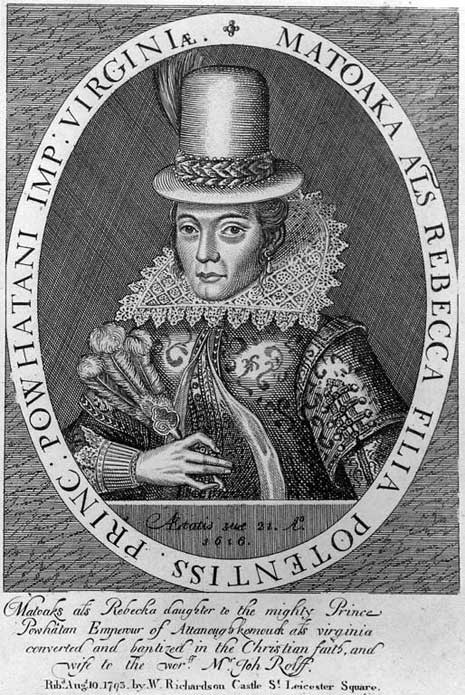From the Collection: Pocahontas

Pocahontas’s only known portrait was created in England, during the last few months of her life. The only surviving record of the sitting is an engraving by Simon van de Passe. This engraving has been the model for many of Pocahontas’s later portraits, including a painting by an unknown artist currently hanging in the National Portrait Gallery. This is believed to be the oldest oil portrait modeled after the van de Passe engraving.
Pocahontas is dressed in English costume in rich shades of red, gold, and green, with white lace cuffs and high collar, a pearl earring, and holding a white and gold ostrich feather fan. To make Pocahontas’s English transformation complete, her skin, hair, and eye color have been significantly lightened.
Pocahontas was the daughter of Washunsenaca or Powhatan, chief of the Powhatan tribe. Born around 1597/98, Pocahontas grew up in her father’s capital, Werowocomoco, located along the Pamunkey (now York) River.
The founding of the Jamestown colony in 1607 brought Captain John Smith to the chief’s attention; the political relationship developed between Smith and Washunsenaca saved the struggling colony. Smith’s departure to England in 1609 for medical needs marked the end of most Powhatan-Jamestown communication until 1613. Of Pocahontas, Mattaponi oral history states that during 1609–13, she came of age, married, moved to the Potowomac tribe on the Potomac River, and had a son.
In 1613, Captain Samuel Argall, a trader who had recently arrived at Jamestown, kidnapped Pocahontas from the Potowomac. Accounts vary, but many historians believe that Pocahontas was kept as a hostage and possibly moved from Jamestown to Henrico, a newer colony upriver. After a year in captivity, Pocahontas was brought to a meeting between the colonists and the Powhatan to discuss the ransom. In his biography of Pocahontas, scholar Philip Barbour quotes an eyewitness account claiming that Pocahontas told her people she wished to stay with the English; according to Mattaponi history, Pocahontas was not given the option to leave. While these conflicting accounts make it difficult to uncover the truth, we do know that after this event, Pocahontas converted to Christianity and married tobacco farmer John Rolfe.
Accounts of Pocahontas’s marriage to and life with Rolfe are, at best, scarce. In 1616, Pocahontas, Rolfe, their son, and several Indian escorts (two of whom are believed to be Pocahontas’s older sister and her husband) journeyed across the Atlantic Ocean to England. While there, Pocahontas met with England’s elite, including the king and queen.
In March 1617, as the Jamestown group was preparing to sail back to the New World, Pocahontas suddenly became ill and died. While many English sources claim a sudden bout of tuberculosis claimed her life, Mattaponi history states that she was murdered, possibly poisoned aboard the ship. Her body was taken to Gravesend, England, where she was buried in the local church.
- Stephanie Sheridan, Intern, Catalog of American Portraits, National Portrait Gallery
Cited:
Philip L. Barbour, Pocahontas and Her World (Boston: Houghton Mifflin, 1970).
Dr. Linwood "Little Bear" Custalow and Angela L. "Silver Star" Daniel, The True Story of Pocahontas: The Other Side of History (Golden: Fulcrum Publishing, 2007).
Helen C. Rountree, Pocahontas Powhatan Opechancanough: Three Indian Lives Changed by Jamestown (Charlottesville: University of Virginia Press, 2005).
Grace Steele Woodward, Pocahontas (Norman: University of Oklahoma Press, 1969)